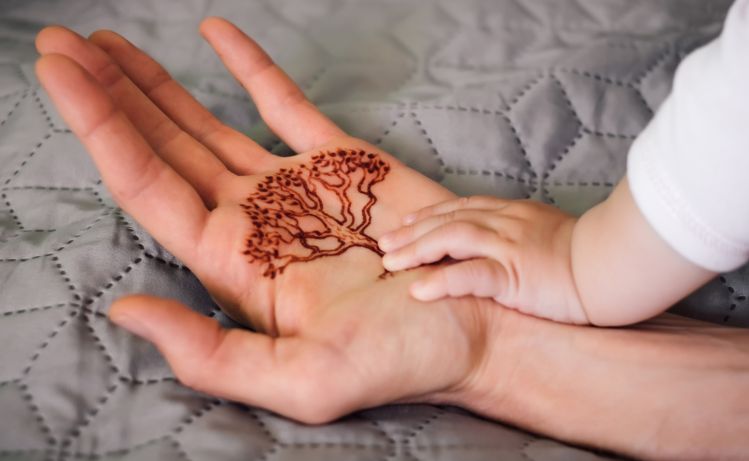Generational trauma is a profound and often unseen force that can shape the lives of entire families and communities. I would know; I’ve been working to break generational trauma as a parent, witnessing firsthand how the echoes of past pain can influence not only my life but also the life of my daughter.
It’s a challenging journey to be a cycle breaking—filled with moments of self-discovery, vulnerability, and the constant effort to create a different narrative for the next generation.
Through the healing process, I’ve come to understand that healing generational trauma isn’t just about confronting the past—it’s about actively choosing a new path forward, one that prioritizes love, understanding, and emotional well-being for myself and my family.

Generational trauma passes down through the layers of time, influencing behaviors, beliefs, and even the mental health of generations. This type of trauma can manifest in various ways, from anxiety and depression to patterns of substance abuse and domestic violence.
I have noticed that some generational trauma has become so ingrained in society and families that it’s actually being normalized, leading to even more difficulty for cycle breakers.
Understanding generational trauma is crucial for breaking the cycle and paving the way for healing. By recognizing the signs of trauma that have been passed down, you can take the first step toward reclaiming your life from the shadows of the past. In this blog, we’ll explore signs of generational trauma, the impact it has on families, and, most importantly, how you can begin the healing process.
Please note: In this article, I’m focusing on generational trauma that many of us might relate to—trauma rooted in behavioral patterns, cultural experiences, and the struggles of everyday life, like growing up in poverty. I want to address the common yet deeply impactful experiences that many families face. For example, generations of living in poverty, dealing with financial instability, or coping with the stress of scarcity, this kind of trauma can shape our lives in powerful ways.
In this article:
Different Types of Trauma
What is Generational Trauma?
Unexpected and Surprising Forms of Generational Trauma
25 Signs of Generational Trauma
Why Becoming a Parent is So Triggering for Our Childhood Trauma
How to Heal Generational Trauma
All of It Is Valid: Different Types of Trauma
Trauma is a deeply personal and multifaceted experience, and it’s important to recognize that no form of trauma is more or less valid than another. Whether it’s a single, life-altering event or a series of subtle, ongoing experiences, all trauma leaves an imprint on our lives and can significantly impact our well-being. Understanding and validating different kinds of trauma is crucial for healing, as it allows us to acknowledge our experiences and begin the process of recovery without judgment or comparison.
Acute Trauma
Acute Trauma typically arises from a single, significant traumatic event—something sudden and overwhelming like a car accident, a natural disaster, or witnessing violence. These events can trigger immediate trauma responses such as shock, fear, and heightened anxiety. The effects of acute trauma are often intense and can lead to conditions like post-traumatic stress disorder (PTSD) if not properly addressed. Even though these experiences are isolated, their impact can be profound, shaping how we perceive the world and interact with others.
Chronic Trauma
Chronic Trauma, on the other hand, results from prolonged or repeated exposure to distressing situations, such as ongoing domestic violence, emotional abuse, or living in a war-torn region. The cumulative effect of enduring trauma over an extended period can lead to complex emotional and psychological challenges, including feelings of hopelessness, disconnection, and a constant state of hypervigilance. The continuous nature of chronic trauma can make it difficult to pinpoint its exact origin, but its impact is no less significant than that of acute trauma.

Historial Trauma or Collective Trauma
Historical Trauma refers to the collective emotional and psychological wounds passed down through generations, often within specific communities that have experienced significant traumatic events such as colonization, slavery, or genocide. Examples include the trauma experienced by Indigenous peoples, African Americans, and children of Holocaust survivors.
This type of trauma is deeply embedded in family history and cultural identity, influencing not just individual family members but entire communities. The effects of historical trauma can manifest in various ways, including mental health issues, substance abuse, and even epigenetic changes that alter how genes are expressed in future generations.
Vicarious Trauma or Secondary Trauma
Vicarious Trauma or Secondary Trauma occurs when someone is indirectly exposed to trauma, often through close relationships or professional work with trauma survivors. For instance, therapists, social workers, and even family members of trauma survivors may experience vicarious trauma as they absorb and empathize with the traumatic experiences of others.
Although they have not experienced the trauma firsthand, the emotional toll can be heavy, leading to symptoms similar to those seen in direct trauma survivors, such as anxiety, depression, and burnout.
Developmental Trauma
Developmental Trauma occurs when children experience ongoing, early trauma during critical periods of their development, such as emotional neglect, physical abuse, or parentification. These experiences can disrupt normal childhood development, leading to issues with emotional regulation, attachment, and cognitive development. Developmental trauma can have long-lasting effects, influencing an individual’s ability to form healthy relationships and navigate the complexities of adult life.
Intergenerational Trauma or Generational Trauma
Lastly, Intergenerational Trauma or Generational Trauma is the trauma passed down through families, which is what this blog will focus on; this type of trauma is often without explicit acknowledgment. It can be the result of past experiences of traumatic events that leave a lasting impact on how family members relate to one another and the world.
This type of trauma might manifest as transgenerational trauma, where behavioral patterns and emotional wounds are passed from one generation to the next, sometimes without any conscious awareness of their origin.

All types of trauma are valid
It’s essential to remember that all these forms of trauma are valid. There is no hierarchy of suffering; what matters is how these experiences affect you and your life. Whether your trauma is recent or rooted in the distant past, whether it was a single event or a series of subtle slights, your feelings and experiences are legitimate.
What is Generational Trauma?
Generational trauma, also known as transgenerational or multigenerational trauma, refers to the psychological effects of trauma that are passed down from one generation to the next. This type of trauma doesn’t only impact the individuals who originally experienced it; it leaves a lasting mark on their descendants, affecting how they view the world, interact with others, and even how their bodies respond to stress.
Understanding this concept is key to recognizing its signs and finding ways to heal. The mechanisms through which generational trauma is passed down are complex and multifaceted.
Epigenetic changes—alterations in gene expression caused by environmental factors rather than changes in the DNA sequence itself—are one way that trauma can be inherited.
These changes can make descendants more susceptible to mental health conditions like post-traumatic stress disorder (PTSD) and depression. Have you been told that depression runs in the family? It could be from generational trauma that can be healed.
Other types of generational trauma can include patterns of domestic violence that are passed down through families. For example, a parent who experienced domestic violence as a child may, without realizing it, recreate similar dynamics in their own household.
This could manifest as repeating abusive behaviors, tolerating toxic relationships, or being unable to establish healthy boundaries, all of which can perpetuate the cycle of trauma. These behaviors and responses often stem from deeply ingrained survival mechanisms that were developed to cope with the original trauma.
Unfortunately, these patterns can be passed on to the next generation, becoming deeply embedded in the family history and teaching children that such dynamics are normal or inevitable. This perpetuates the cycle of abuse and trauma, making it difficult for future generations to recognize these behaviors as traumatic experiences rather than just part of their family’s way of life.
Over time, these patterns can become so entrenched that they seem almost impossible to break, affecting not just the immediate family but potentially rippling out to impact future generations as well.

Unexpected and Surprising Forms of Generational Trauma
When we think about generational trauma and transgenerational trauma, our minds often jump to obvious forms of suffering, such as domestic violence, substance abuse, natural disasters, or historical trauma stemming from significant traumatic events or atrocities. However, generational trauma can also take on more subtle, unexpected forms that are just as damaging, though they may not be as immediately recognized.
These types of trauma can weave their way into the fabric of daily life, passed down through well-meaning behaviors and societal norms, leaving a lasting impact not only on the individuals directly involved but also on their family members and future generations.
Parentification and Generational Trauma
Parentification happens when a child is forced to take on the role of a caregiver for their parents or siblings at an early age. This can happen in families where a parent is emotionally unavailable due to issues like mental illness, substance abuse, or chronic stress. The child, often the oldest, steps into the role of a pseudo-adult, managing responsibilities that are far beyond their years.
While this may foster resilience and independence, it can also lead to feelings of deep resentment, burnout, and the inability to form healthy adult relationships later in life. The trauma of being thrust into an adult role too soon is often overlooked, but it can leave emotional scars that persist across generations. This is a type of trauma that can often be repeated in families.
Emotional Neglect and Generational Trauma
Emotional abuse and neglect are other forms of trauma that can be subtly passed down through families. Unlike physical abuse, emotional abuse might not leave visible scars, but its impact can be just as severe. In many families, this type of behavior is accepted as normal because “that’s how mom/dad/grandma/grandpa is.”
Emotional neglect—where a child’s emotional needs are consistently overlooked or minimized—can lead to a deep sense of emotional emptiness or difficulty forming intimate relationships in the future. This form of neglect often stems from cultural norms that were particularly prevalent in older generations, where emotions were frequently dismissed or ignored. We can see this playing out now in our society where older generations may perceive a show of emotions as weakness (aka “being a snowflake).
In many families, especially those shaped by hardship or historical trauma, expressing emotions was seen as a sign of weakness.
The focus was on survival, and there was little room for emotional expression or vulnerability.
This mindset, passed down from parents to children, created an environment where emotional needs were not acknowledged, let alone met.
For example, in past generations, children might have been told to “toughen up” or “stop crying” when they expressed distress or sadness. This attitude was often a reflection of the times, where showing emotions was not considered appropriate or helpful, especially in the face of significant traumatic events like war, economic depression, or other societal challenges.

Parents who grew up in these environments learned to suppress their own emotions, believing that this was the best way to protect themselves and their families. As a result, they unintentionally passed down the same emotional stoicism to their children.
This culture of emotional suppression created a cycle where each subsequent generation became more disconnected from their own feelings and those of others. Children raised in such environments often grow up feeling emotionally isolated, unable to fully understand or process their emotions because they were never taught how.
This can lead to challenges in forming deep, intimate relationships, as they may struggle to express their needs, fears, and desires openly.
They may also find it difficult to empathize with others, having learned from a young age that emotions should be kept hidden or are not important.
The impact of this type of emotional neglect can be profound, often leading to mental health issues such as depression, anxiety, and a pervasive sense of loneliness. Without the tools to navigate their emotions, individuals may turn to unhealthy coping mechanisms, further perpetuating the cycle of trauma within the family.
This legacy of emotional neglect is a subtle yet powerful form of generational trauma that can leave lasting scars, making it essential to recognize and address these patterns in order to foster healthier emotional environments for future generations.
What are the Signs of Generational Trauma?
Generational trauma can manifest in a variety of ways creating ripple effects in your family. These traumas often subtly influence behaviors, emotions, and family dynamics. These signs may not always be immediately recognizable, as they are often deeply ingrained in the family history and passed down from one generation to the next.
1. Scarcity Mindset: This is a persistent fear of not having enough, leading to anxiety around money, hoarding behavior, and an inability to enjoy or spend resources, even when they are available. Growing up in a household ruled by scarcity can make it very difficult to get out of the scarcity pattern.
2. Chronic Financial Instability: A recurring pattern of financial struggles and difficulty breaking out of poverty, often passed down through generations, where each generation faces similar economic hardships.
3. Overworking or Burnout: The belief that working excessively hard is the only way to survive, leading to chronic stress, burnout, and physical health issues due to an ingrained sense of responsibility and fear of failure.

4. Mental Health Issues: Ongoing struggles with depression, anxiety, and other mental health conditions, which are often rooted in the stress and trauma of living in poverty and passed down from one generation to the next.
5. Distrust of Financial Systems: Deep-seated mistrust of banks, investments, or government assistance, often stemming from past experiences of exploitation or financial loss, which leads to avoidance of financial institutions and missed opportunities for financial growth.
6. Ingrained Feelings of Unworthiness: A belief that you don’t deserve better circumstances, often stemming from generations of being told that you’re “not good enough” or “not meant to succeed,” resulting in self-sabotage and a lack of ambition.
7. Hypervigilance Around Spending: Extreme anxiety about spending money, even on basic needs, due to a long history of financial scarcity. This can lead to a reluctance to invest in oneself or one’s future.
8. Lack of Educational Opportunities: A pattern of limited access to education, leading to a cycle of low-paying jobs and limited upward mobility. This perpetuates a cycle where each generation struggles with similar economic challenges.
9. Shame Around Poverty: Deep feelings of shame associated with being poor, which can lead to secrecy, isolation, and reluctance to seek help. This shame can also manifest as a reluctance to discuss financial issues openly, even within the family.
10. Fractured Family Dynamics: Strain in family relationships caused by the stress of financial struggles, leading to conflict, breakdowns in communication, and emotional distance. These strained relationships can further perpetuate the cycle of trauma and hardship.
11. Normalization of Hardship: Accepting struggle and suffering as normal or inevitable, which can lead to a lack of ambition or hope for better circumstances. This mindset can be passed down, teaching future generations to expect and accept less from life.
12. Inherited Health Issues: Physical health problems, such as chronic stress-related conditions, that stem from the long-term impact of living in poverty. Chronic stress can weaken the immune system, leading to an increased risk of illness.
13. Fear of Taking Risks: Reluctance to take risks, such as pursuing new opportunities or making investments, due to a deep fear of loss or failure. This fear is often rooted in past experiences of financial instability and can prevent individuals from seeking better opportunities.
14. Generational Patterns of Debt: A cycle of accumulating debt, often passed down from parents to children, leading to ongoing financial instability. This pattern can create a sense of hopelessness and a belief that financial freedom is unattainable.
15. Emotional Repression: Suppressing emotions like fear or sadness to “stay strong” in the face of financial hardship, leading to difficulty expressing or processing emotions. This emotional repression can manifest in various ways, such as numbness or emotional detachment.
16. Low Self-Esteem: Feelings of inadequacy and a belief that you can’t belong or won’t be accepted, often stemming from a lifetime of societal messages that equate poverty with failure. This can lead to self-sabotaging behaviors and a reluctance to pursue personal growth.
17. Difficulty Trusting Others: Difficulty trusting others, particularly those outside of one’s immediate family or community, which can be rooted in older generations who spoke poorly about other cultures or groups. This distrust can lead to isolation and a lack of social support.
18. Emotional Volatility: Anger and domestic violence can be passed down through generations, often seen in subtle ways such as spanking or slapping as forms of discipline. This emotional volatility creates an environment of fear and instability, perpetuating the cycle of trauma.

19. Substance Abuse: Substance misuse can occur with both illegal and legal substances. I’ve seen many families normalize alcoholism because it’s that’s how the family engages and connects. For both the individual and the group as a whole, this behavior is done to numb emotional pain and cope with hardships.
20. Isolation: Some families discourage members from engaging with new people or becoming part of different groups. The family is seen as the primary and sometimes only source of support, leading to an insular mindset where interactions outside the family are viewed with suspicion. This can result in a lack of social connections and support networks, making it difficult for individuals to seek help, grow, or break free from generational patterns.
21. Relationship Issues: It can be difficult to build healthy relationships when you didn’t learn what a healthy relationship looks like from childhood. This can lead to challenges in adulthood as you struggle with boundaries, communication, and even intimacy.
22. Chronic Illness and Chronic Pain: The long-term effects of trauma can change your brain and body, leading to chronic illness and pain. Trauma can disrupt the body’s normal functioning, leading to persistent health issues that are difficult to treat and often misunderstood. It can even lead to autoimmune disorders.
23. Limited Access to Resources: A lack of access to important resources, such as healthcare or nutritious food, which perpetuates cycles of poor health and economic struggle across generations. This limited access reinforces the cycle of poverty and trauma, making it difficult to break free.
24. Rigid Gender Roles: Adherence to strict, traditional gender roles that limit personal expression and growth, often stemming from cultural norms rooted in past trauma. This can restrict opportunities and create additional stress within the family unit.
25. Generational Guilt and Shame: Feelings of guilt or shame passed down from one generation to the next, often related to past failures or the burden of not overcoming poverty. This can manifest as a constant need to prove oneself or an inability to feel pride in one’s accomplishments.
Why Becoming a Parent is So Triggering for Our Childhood Trauma
Are you a parent who feels like you are living on the edge because you are constantly triggered? I get it. Becoming a parent is one of the most profound and transformative experiences in life. It brings with it a deep sense of responsibility, love, and connection, but it can also be incredibly triggering for unresolved childhood trauma.
This paradox arises because the act of parenting often brings to the surface our own past experiences, especially those that were difficult, painful, or traumatic (whether you are conscious of it or not). As we navigate the challenges of raising our own children, we may find ourselves unexpectedly confronted with memories, emotions, and behaviors that we thought were long buried.

One of the primary reasons parenting can be so triggering is that it activates our inner child.
The inner child represents the part of our psyche that holds onto the experiences, emotions, and memories from our early years, particularly those shaped by trauma.
When we’ve experienced childhood trauma, the pain from those early years often resides deep within our subconscious. As a parent, when your child does something that stirs a strong emotional response, it’s frequently because your inner child has been triggered, bringing those old, unresolved feelings to the surface once again.
When we’ve experienced childhood trauma, there are many vital skills and emotional tools that we may not have learned, which can become significant pain points when we become parents ourselves. One of the most crucial of these is the ability to cope effectively with strong emotions. In a healthy, supportive environment, children learn how to navigate their feelings—how to process anger, sadness, fear, and joy in constructive and healthy ways. They are guided by caring adults who model emotional regulation, empathy, and resilience.
However, if we grew up in an environment where our emotions were dismissed, ignored, or even punished, we likely didn’t develop these essential coping skills. Instead, we may have learned to suppress our emotions, deny our feelings, or react in ways that are defensive or destructive. As a result, when we encounter strong emotions as parents—whether from our children or within ourselves—we may find it incredibly challenging to manage them effectively.
For instance, if you were never taught how to handle frustration as a child, you might find yourself easily overwhelmed when your child throws a tantrum or when things don’t go as planned.
This can lead to feelings of anger, helplessness, or even shame, as you struggle to control the situation or your own reactions.

Similarly, if you weren’t given the space to express sadness or fear growing up, you might feel uncomfortable or inadequate when your child comes to you with these emotions. Instead of offering comfort and support, you might inadvertently mirror the dismissive responses you received, perpetuating a cycle of emotional neglect.
Additionally, without proper emotional guidance in childhood, we may also struggle with boundaries. Healthy boundaries are essential for managing relationships and emotions, yet if we didn’t learn how to set or respect them as children, we might find it difficult to establish them with our own kids.
This can manifest in various ways—overreacting to minor issues, feeling responsible for our children’s emotions, or, conversely, withdrawing emotionally to protect ourselves from feeling overwhelmed.
These unlearned skills and unresolved emotional wounds can create significant pain points in parenting, as we find ourselves reacting from a place of old hurt rather than responding with the calm, centered presence that our children need. The stress of trying to parent effectively while also grappling with our own unresolved trauma can lead to feelings of guilt, inadequacy, and frustration.
How to Heal Generational Trauma
Healing generational trauma is a journey that requires patience, self-compassion, and a deep commitment to breaking the patterns that have been passed down through your family.
While the process can be challenging, it is also incredibly empowering. By taking steps to heal, you not only transform your own life but also create a healthier foundation for future generations. Here are some strategies to help you on this journey:
Acknowledge the Trauma: The first step in healing is to recognize and acknowledge the presence of generational trauma. This involves reflecting on your family history, identifying patterns of behavior or beliefs that have been passed down, and understanding how they have impacted your life. It’s important to accept that these patterns exist and that they are not your fault, but rather a legacy of past experiences.
Seek Professional Help: Working with a mental health professional who specializes in trauma can be incredibly beneficial. Therapies such as Cognitive-Behavioral Therapy (CBT), Eye Movement Desensitization and Reprocessing (EMDR), and Somatic Experiencing are particularly effective in addressing trauma. A therapist can help you explore the roots of your generational trauma, process painful memories, and develop healthier coping mechanisms.
Educate Yourself: Understanding the science and psychology behind generational trauma can empower you to take control of your healing journey. Educate yourself on topics such as epigenetics, trauma responses, and the impact of stress on the body and mind. Knowledge can help demystify your experiences and provide a roadmap for healing.

Practice Mindfulness and Self-Care: Mindfulness practices such as meditation, deep breathing, and yoga can help you stay present and manage the emotional responses that arise when dealing with trauma.
Regular self-care is also essential—this might include journaling, spending time in nature, engaging in creative activities, or simply taking time to rest and recharge.
Build Healthy Relationships: Surround yourself with supportive, understanding people who respect your healing journey. Building strong, positive relationships can help counteract the effects of isolation and mistrust that often accompany generational trauma. Consider joining a support group where you can connect with others who are on a similar path.
Set Boundaries: Learning to set and maintain healthy boundaries is crucial in healing from generational trauma. This might involve limiting contact with family members who perpetuate toxic behaviors, or it could mean establishing new, healthier patterns of interaction within your family. Boundaries help protect your emotional well-being and allow you to create a safe space for healing.
Break the Cycle Through Intentional Parenting: If you have children, one of the most powerful ways to heal generational trauma is through intentional, conscious parenting. By being aware of your own triggers and actively working to parent differently than you were parented, you can break the cycle and provide your children with a more nurturing, supportive environment.
Embrace Forgiveness: Forgiving those who have hurt you, whether they are family members or ancestors, can be a powerful step in healing. This doesn’t mean excusing harmful behavior, but rather releasing the hold that past pain has on you. Forgiveness can free you from the emotional weight of resentment and open the door to peace and healing.
Create New Family Traditions: Establishing new, positive family traditions can help replace the negative patterns of the past with ones that are nurturing and life-affirming. These traditions can be simple, like regular family dinners, or more elaborate, like annual retreats. The goal is to create a sense of connection and support within your family.
Seek Connection with Ancestors: For some, connecting with ancestors can be a healing process. This might involve researching your family tree, learning about your cultural heritage, or engaging in rituals that honor those who came before you. Understanding the struggles and strengths of your ancestors can provide context for your own experiences and help you find strength in their resilience.
Embrace Continuous Growth: Healing is not a one-time event but a continuous process. As you grow and evolve, you may uncover new layers of trauma or old wounds that need attention. Embrace this as part of your journey and allow yourself the grace to heal at your own pace.
Healing generational trauma is a brave and transformative journey. It requires confronting the past, embracing the present, and consciously creating a healthier future. By taking these steps, you can break the cycle of trauma and build a legacy of resilience, love, and strength for yourself and future generations.
Conclusion
Generational trauma is a complex and deeply rooted issue that can have a profound impact on individuals and families, often in ways that are not immediately visible. Whether it stems from centuries of living in poverty, rigid cultural norms, or the emotional wounds passed down through generations, this type of trauma influences our beliefs, behaviors, and interactions in significant ways.
Recognizing the signs of generational trauma is the first crucial step toward healing. By understanding how these patterns have shaped our lives, we can begin to break the cycle and create a healthier, more resilient future for ourselves and our children.
Healing from generational trauma isn’t easy, but it is possible. It requires a commitment to self-awareness, a willingness to confront painful truths, and the courage to seek out new ways of thinking and living. Whether through therapy, education, or building supportive communities, we have the power to rewrite our stories and transform the legacy we leave behind.
By addressing the trauma that has been passed down to us, we not only heal ourselves but also pave the way for future generations to live freer, more empowered lives. Remember, all trauma is valid, and every step toward healing is a step toward breaking the cycle and creating a brighter, more hopeful future.














